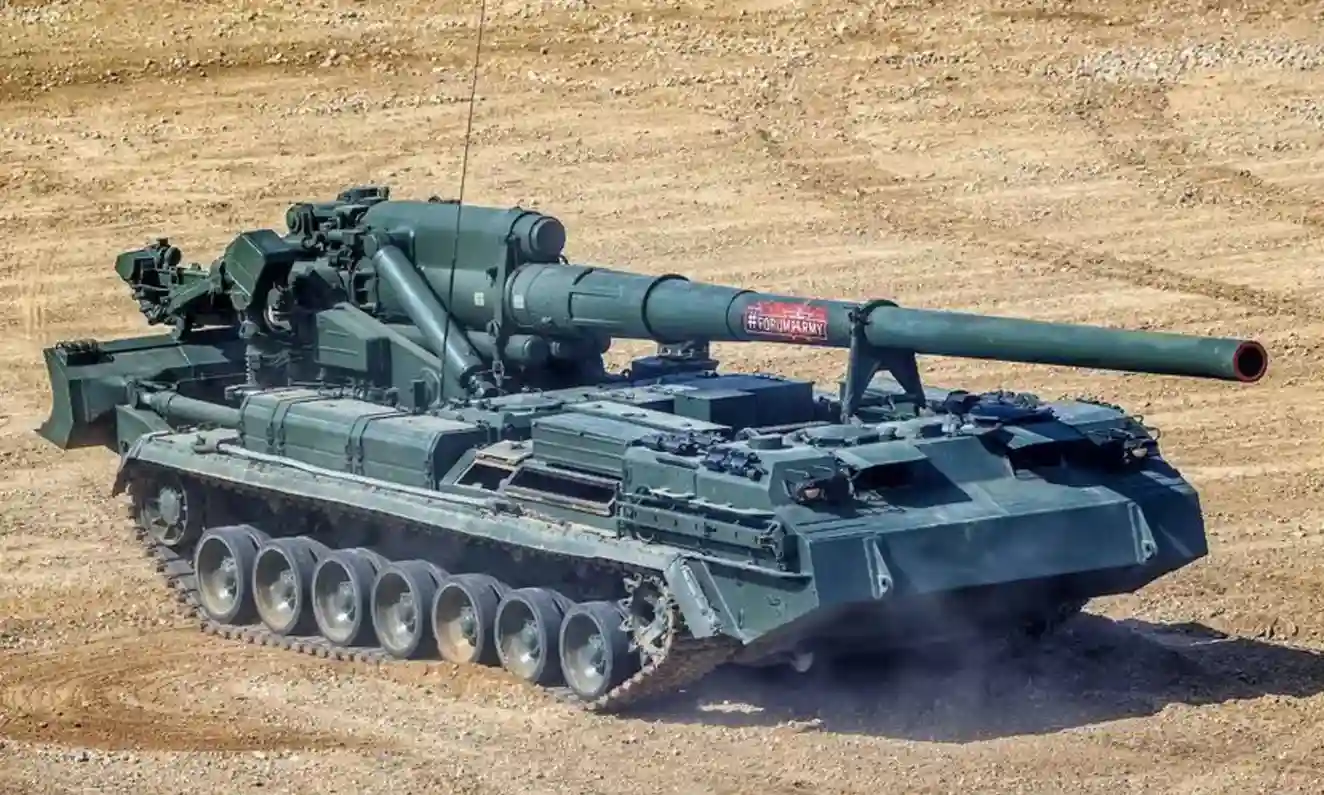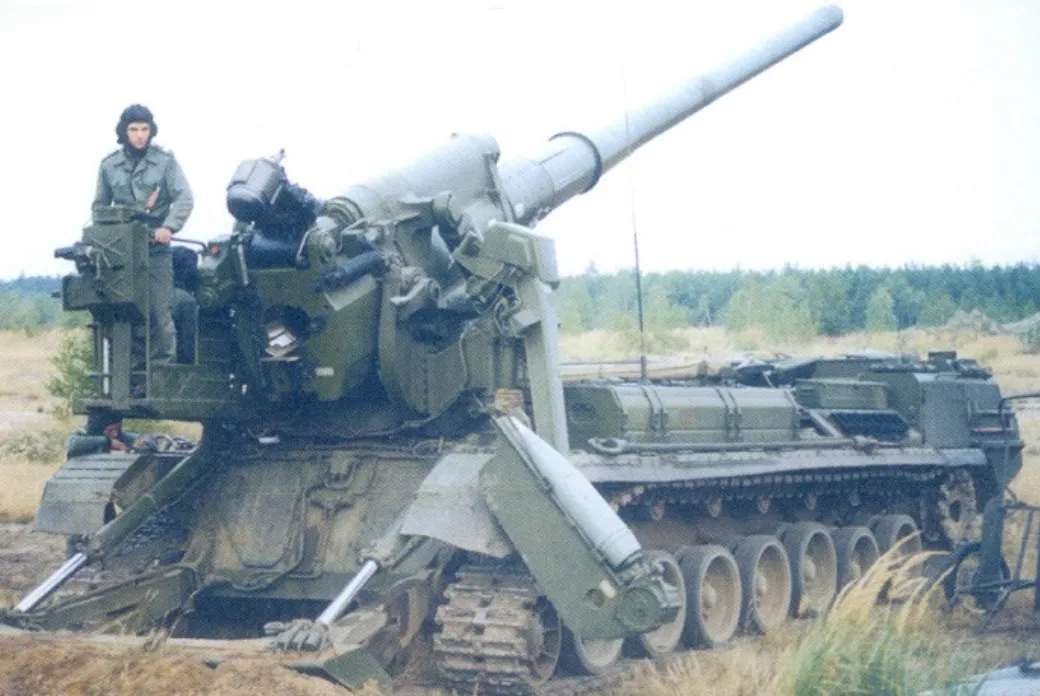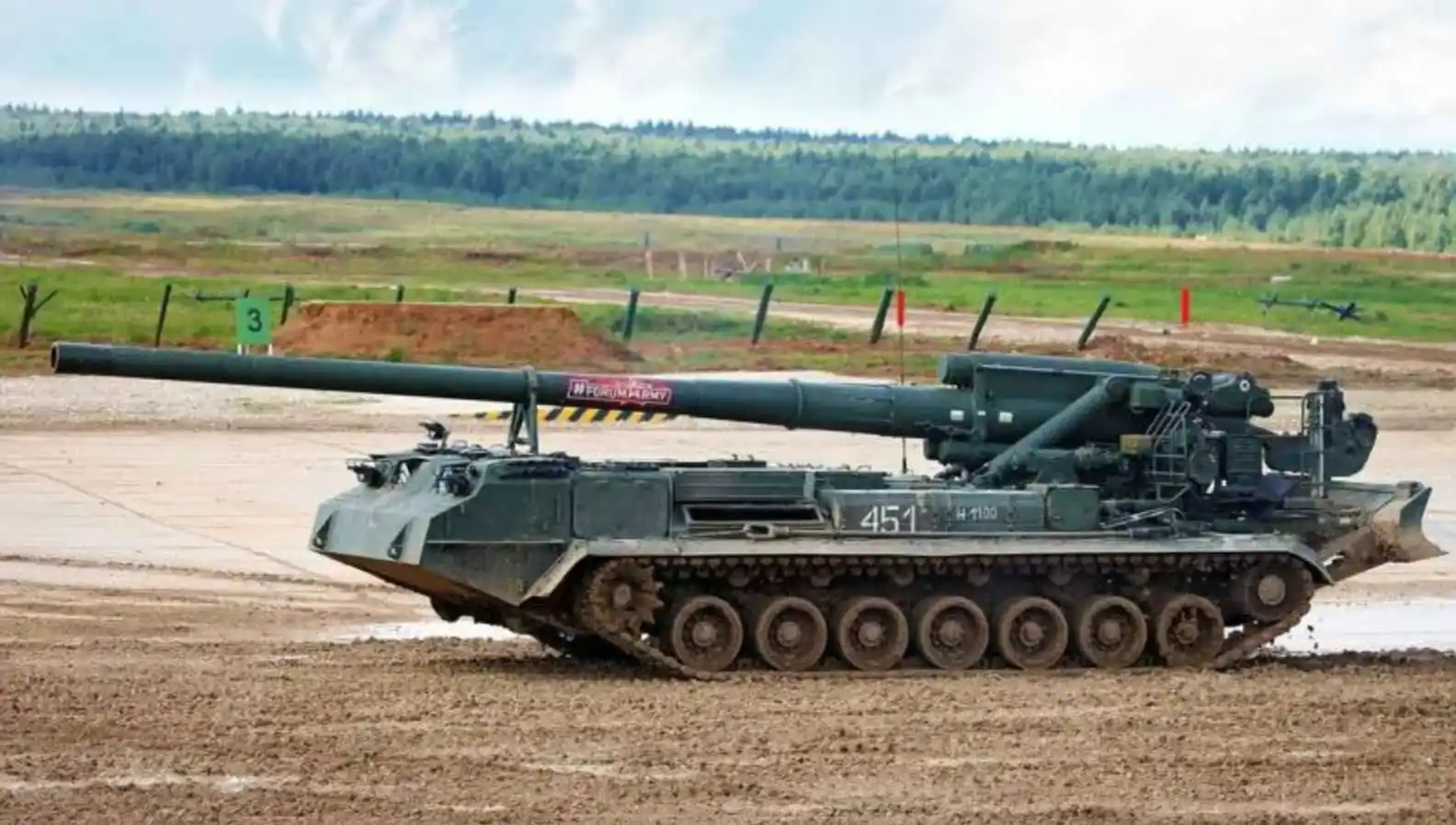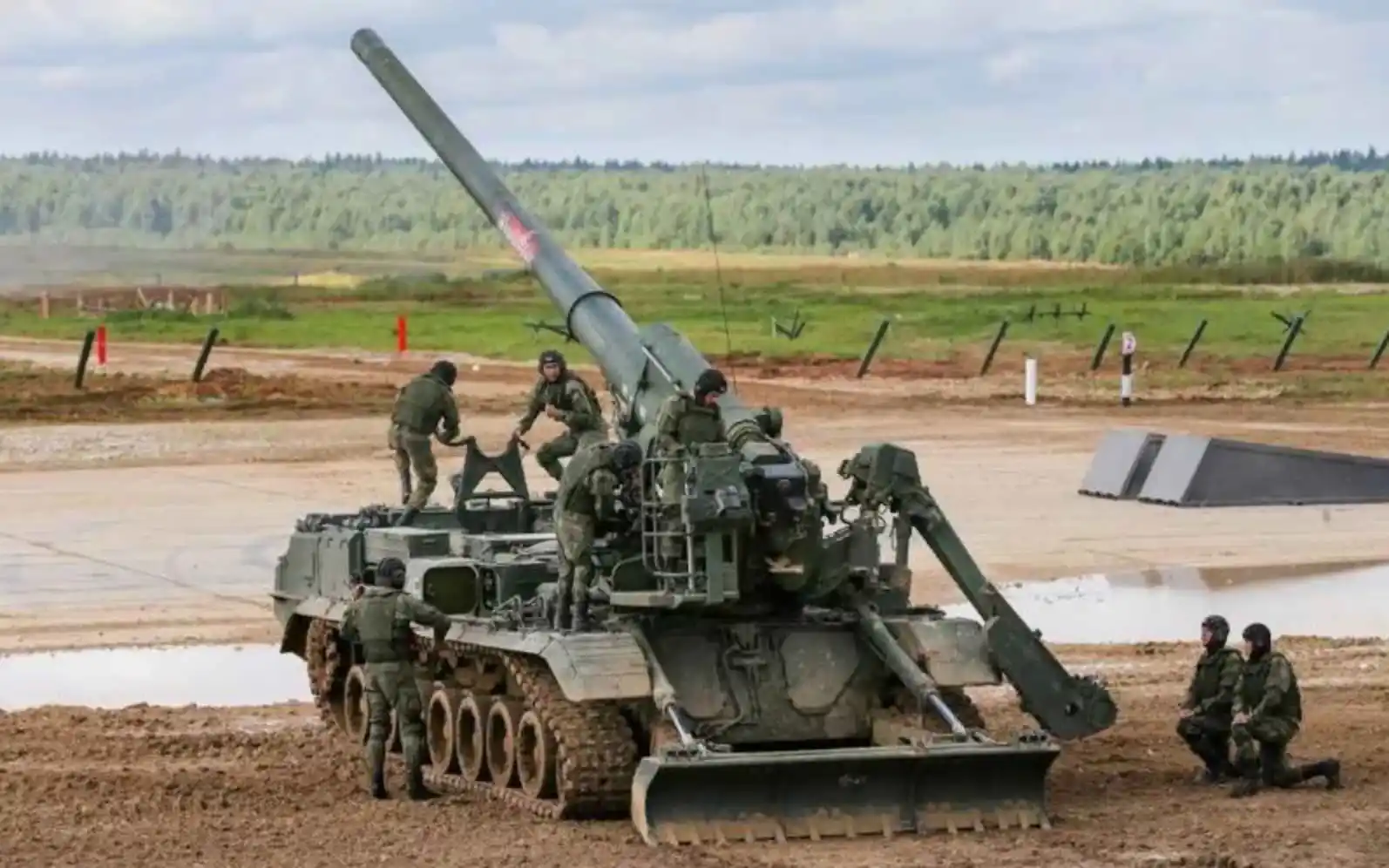Follow Us:

Share
The 2S7 Pion Artillery is one of the most formidable 203mm self propelled artillery systems ever developed. Designed by the Soviet Union during the Cold War, this massive weapon continues to hold relevance in military operations around the world.
Known for its incredible firepower and long-range capabilities, the 2S7 Pion 203mm is a subject of interest for military enthusiasts and defense analysts alike.
This article dives deep into the history, technical specifications, and legacy of this artillery system, offering an in-depth look at its place in modern warfare.
The 2S7 Pion is a Soviet-designed self-propelled heavy artillery system that entered service in the late 1970s.
Known for its ability to fire 203mm shells at long ranges, the Pion was initially developed to meet the need for a highly mobile, long-range artillery platform capable of delivering devastating firepower on enemy positions.
With a range of up to 47 kilometers using specialized rounds, this artillery system quickly became a vital tool in the Soviet arsenal.

Key Facts About the 2S7 Pion:
The 2S7 Pion Artillery was developed in the late 1960s to replace older artillery systems that lacked the range and mobility required by the Soviet military.
The system was designed to engage strategic targets, including enemy command centers, fortifications, and troop concentrations, with unparalleled destructive power.
By 1975, the 2S7 Pion Artillery had entered service with the Soviet Army and would go on to see deployment in numerous conflicts, including the Soviet-Afghan War.

This artillery system was also exported to other Warsaw Pact nations, and even today, variants of the Pion are still in service with several countries, including Russia.
Its long-range artillery capability made it a critical component in Soviet and later Russian military doctrine, especially in large-scale, conventional warfare scenarios.
Fun Fact: The 2S7 Pion is also known by the nickname Malka in its modernized version, a name that continues to evoke its massive firepower and strategic value on the battlefield.
The 2S7 Pion Malka is an incredibly complex and powerful piece of artillery. Its design reflects the Soviet military’s emphasis on long-range, highly destructive firepower.
The technical specifications of the 2S7 Pion highlight its advanced engineering for its time and explain why it continues to serve in modern armies.

At the heart of the 2S7 Pion is its 203mm 2A44 cannon, a massive artillery piece capable of firing a variety of ammunition types, including high-explosive fragmentation and nuclear-capable shells.
The sheer size of the cannon makes it one of the largest self-propelled artillery systems ever created.
Range:
Such a long-range provides the 2S7 Pion with the ability to target enemy positions far behind the front lines, making it a highly strategic weapon.
This makes the Pion invaluable for disrupting enemy logistics, command posts, and reinforcements.
Despite its immense size and firepower, the 2S7 Pion Artillery is built on a tracked chassis, giving it relatively good mobility for a weapon of its class.
The chassis is based on the T-80 tank, which was one of the most advanced tank platforms at the time.

The mobility of the 2S7 Pion allows it to keep up with mechanized units and relocate after firing, a critical ability in modern warfare to avoid counter-battery fire.
While the 2S7 Pion is not the most agile vehicle, its tracked platform allows it to traverse difficult terrains such as mud, snow, and rough landscapes, making it a versatile option for military operations in various environments.
Given its role as a long-range artillery system, the 2S7 Pion Artillery is not heavily armored compared to main battle tanks or infantry fighting vehicles.
Its primary defense lies in its ability to fire from well behind the front lines, out of reach of most direct fire.
However, the system does have basic protection for the crew against small arms fire and artillery fragments.
Operating a 2S7 Pion requires a skilled and coordinated crew, given the complexity and size of the system.
The crew consists of 7 members, each with specific roles to ensure the efficient operation of the artillery system.

The setup time for the 2S7 Pion Artillery is relatively long compared to lighter artillery systems. Once in position, the crew requires time to deploy the gun and prepare it for firing.
This can be a drawback in fast-moving combat situations, but its long-range compensates for the relatively slow deployment process.
The 2S7 Pion Artillery uses a semi-automatic loading system to assist the crew in handling the large 203mm shells.
However, the rate of fire is still low—typically about 1.5 rounds per minute—due to the size of the ammunition and the need to reposition the system between shots to avoid counterfire.
The 2S7 Pion has an extensive history of operational use, having been deployed in various military conflicts since its introduction in the 1970s.
As one of the Soviet Union’s most powerful artillery systems, its significance in Cold War-era planning and later conflicts is undeniable. This section will explore its role in both historical and modern military engagements.
The 2S7 Pion Artillery was developed during the height of the Cold War, a period of intense military competition between the Soviet Union and the Western powers.
It was designed to fill the gap between conventional artillery and tactical nuclear weapons, allowing the Soviet military to strike deep into enemy territory while remaining mobile enough to keep pace with fast-moving mechanized units.
While the 2S7 Pion was initially created for the Soviet Army, it was also distributed to other Warsaw Pact nations, such as East Germany, Poland, and Czechoslovakia.
This distribution was part of the Soviet strategy to ensure that its allies could independently mount large-scale artillery attacks, providing a formidable defensive and offensive capability across Eastern Europe.
The 2S7 Pion’s presence in these countries was a direct response to NATO’s growing technological advancements, particularly in air and missile defense.
By deploying artillery systems like the Pion, the Soviets ensured that they could counterbalance any NATO attempt at strategic dominance.
The 2S7 Pion Artillery did not fade into obscurity after the Cold War. Instead, it continued to see operational use in a variety of modern conflicts, particularly by the Russian Federation.
The system has been used in some of the most intense and strategically significant battles in recent years, proving its enduring value.
During the Soviet invasion of Afghanistan (1979-1989), the 2S7 Pion was deployed to provide long-range artillery support for Soviet forces.
The mountainous terrain and guerrilla tactics of the Mujahideen required the Soviet military to have weapons capable of hitting targets from extreme distances.
The 2S7 Pion was used to target Mujahideen fortifications and supply lines, though the difficult terrain limited its mobility in some cases.
The 2S7 Pion was used during the First and Second Chechen Wars as part of the Russian Federation’s artillery strategy to suppress Chechen insurgents.
The system’s long-range capabilities were particularly useful in engaging entrenched positions and urban strongholds in Grozny, the capital of Chechnya.
Due to its high firepower, the Pion played a key role in softening resistance before ground troops advanced.
In the ongoing conflict between Russia and Ukraine, the 2S7 Pion Artillery has been seen in action once again.
The artillery system has been used to shell Ukrainian positions from long distances, particularly in contested regions such as Donetsk and Luhansk.
Its ability to fire over long ranges and hit deep behind enemy lines makes it an important asset for the Russian Army in this conflict, especially in situations where close combat is less practical.
Today, several countries continue to operate the 2S7 Pion Artillery, despite the system being over 40 years old. This includes:
The real-world performance of the 2S7 Pion Artillery has been both praised and critiqued. In scenarios where long-range artillery is crucial, the Pion has proven to be an irreplaceable asset.
However, its drawbacks, including its relatively slow rate of fire and the logistics required to maintain and resupply it, have limited its effectiveness in fast-paced, modern warfare.

Strengths:
Weaknesses:
As military technology continues to evolve, the 2S7 Pion Artillery faces a rapidly changing battlefield landscape where modern systems are expected to deliver both mobility and firepower.
Despite being developed in the 1970s, the 2S7 Pion remains relevant today. However, there are questions about its future viability and the ongoing upgrades necessary to ensure it can meet the demands of 21st-century warfare.
To keep the 2S7 Pion Artillery relevant in modern military conflicts, Russia has initiated several modernization programs to upgrade the system, primarily in the form of the 2S7M Malka variant.
These 2s7 pion model upgrades focus on improving the artillery system’s mobility, firepower, and survivability in the face of modern threats.
The 2S7M Malka is the modernized version of the 2S7 Pion Artillery, introduced in the 1980s to enhance the system’s capabilities.
The upgrades addressed several of the original system’s limitations while introducing new features to make it more competitive on the modern battlefield.
Key Upgrades in the 2S7M Malka:
Fun Fact: The modernized 2S7M Malka version still retains the ability to fire nuclear-capable shells, maintaining its role as a strategic deterrent in Russia’s military doctrine.
Another area of modernization for the 2S7 Pion Artillery involves its ammunition. Recent developments in artillery ammunition have allowed for increased range and precision.
Rocket-assisted projectiles (RAP) continue to play a crucial role in extending the range of the Pion to its maximum distance of 47 km, and ongoing improvements aim to push these limits even further.
As one of the most powerful self-propelled artillery systems in the world, the 2S7 Pion Artillery has garnered a lot of interest from military enthusiasts, analysts, and defense experts.
Below are some of the most frequently asked questions about the 2S7 Pion, addressing key aspects of its capabilities, deployment, and future.
Yes, the 2S7 Pion is still actively used by several militaries around the world, particularly by the Russian Army.
Despite being developed during the Cold War, its unique combination of long-range capabilities and massive firepower has kept it relevant. Modernized versions, like the 2S7M Malka, have further extended its operational life.
Countries such as Russia, Ukraine, and some former Soviet states continue to deploy the 2S7 Pion in both strategic and tactical roles.
Recent conflicts, especially in Ukraine, have demonstrated that the Pion still plays a key role in artillery battles, providing long-range bombardments in areas where other artillery systems fall short.
Yes, one of the most significant aspects of the 2S7 Pion is its ability to fire tactical nuclear shells.
This capability was part of its original design during the Cold War when nuclear-capable artillery was considered an important part of Soviet military doctrine.
The 2S7 Pion can fire 203mm nuclear rounds, making it a key asset in the context of nuclear deterrence and strategic military planning.
While the use of nuclear artillery is highly controversial and governed by strict international agreements, the presence of this capability gives the 2S7 Pion a unique strategic value.
Note: The nuclear capability of the Pion remains an essential feature in Russian military doctrine, particularly as part of its tactical nuclear strategy.
The 2S7 Pion has an impressive maximum range of 37.5 kilometers with standard high-explosive shells.
However, when using rocket-assisted projectiles (RAP), the system’s range extends to 47 kilometers, making it one of the longest-ranged self-propelled artillery systems still in service.
This range allows the 2S7 Pion to target enemy positions deep behind the front lines, including command centers, supply depots, and reinforcements, without ever coming within range of most conventional artillery systems.
The 2S7 Pion stands out primarily for its combination of long-range capabilities and massive firepower, thanks to its 203 mm howitzer cannon.
In comparison to modern Western systems, such as the M109 Paladin or the PzH 2000, the Pion offers superior range but suffers from slower mobility and a lower rate of fire.
When compared to other Russian systems, such as the 2S4 Tyulpan or the BM-30 Smerch, the Pion excels in precise, long-range bombardments, whereas these systems serve more specialized roles, such as close-range heavy mortar fire or area saturation rocket attacks.
Each system plays a distinct role, but the 2S7 Pion remains unique due to its ability to deliver both conventional and nuclear rounds over extreme distances.
The 2S7 Pion Artillery has earned its place in military history as one of the most powerful and long-ranged artillery systems ever created.
Developed during the Cold War to meet the Soviet Union’s need for strategic, long-range firepower, the Pion continues to serve on battlefields today.
Its ability to fire a variety of munitions, including nuclear shells, combined with its impressive range of 47 kilometers, makes it a critical asset in both conventional and strategic military doctrines.
Despite its age and the introduction of more modern artillery systems, the 2S7 Pion remains relevant through upgrades and modernizations, particularly the 2S7M Malka variant.
The system has proven its worth in several conflicts, from the Soviet-Afghan War to the ongoing Russo-Ukrainian conflict, where it has demonstrated its ability to deliver long-range bombardments effectively.
Looking to the future, as artillery continues to play a vital role in military operations, the 2S7 Pion Artillery is likely to remain an important tool in any arsenal that values long-range firepower.
Its combination of versatility, destructive power, and strategic deterrence ensures that this system will not fade into obsolescence any time soon.
Share
Defense Feeds is publication focusing on informing, engaging, and empowering the world by providing accurate information from defense technology.
Powered by Defense Feeds © 2025 – All rights reserved.